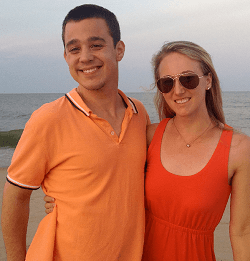Colleen McGavin, a student at the University of Michigan Medical School, explains to the medical community that her brother with Fragile X is not just “a case of Fragile X” but a “beautiful, complex, vulnerable, unique individual who happens to have an unusual X chromosome.”
In this week’s issue of the Journal of the American Medical Association (JAMA), McGavin tells us how not to stereotype the diagnosis or treatment of individuals with Fragile X: “If we can make that shift in our minds, we will be on the way to practicing truly personalized medicine.”
 In one of my first lectures as a medical student, my instructor flashed the image of a young boy’s face on the giant projection screen. The boy’s face was long and his forehead and ears stuck out. According to our genetics professor, this was the face of Fragile X syndrome. I looked at that boy and felt alienated. He didn’t look anything like my brother Carter, who has been the face of Fragile X syndrome for me. An hour later, my classmates and I went on to review a hypothetical case of a healthy 25-year-old woman and her husband who sought genetic counseling after their 2-yearold son was diagnosed with global developmental delay. When my classmates heard that the mother also had a brother with intellectual disabilities, they immediately suggested Fragile X. The instructor confirmed their diagnosis. Case closed. We moved on to drawing pedigrees.
In one of my first lectures as a medical student, my instructor flashed the image of a young boy’s face on the giant projection screen. The boy’s face was long and his forehead and ears stuck out. According to our genetics professor, this was the face of Fragile X syndrome. I looked at that boy and felt alienated. He didn’t look anything like my brother Carter, who has been the face of Fragile X syndrome for me. An hour later, my classmates and I went on to review a hypothetical case of a healthy 25-year-old woman and her husband who sought genetic counseling after their 2-yearold son was diagnosed with global developmental delay. When my classmates heard that the mother also had a brother with intellectual disabilities, they immediately suggested Fragile X. The instructor confirmed their diagnosis. Case closed. We moved on to drawing pedigrees.
While my classmates moved on, I was still thinking about the case and the boy on the screen. I was disappointed with the lessons we had been taught. They seemed simplistic and one-dimensional. The case presented a binary world like that of Mendel’s peas: Disabled boys who inherited a fully mutated X chromosome, and everyone else. We didn’t discuss the potential for variation in Fragile X phenotypes. More importantly, we didn’t discuss the effect of Fragile X on individuals and their families. We had not heard the patient’s story and so had not been reminded of its importance. How could we be trained to address our patients’ needs if we had not been advised to listen to their stories?
Read more at JAMA

